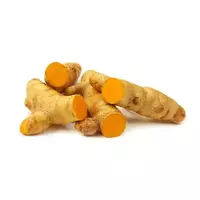Turmeric root

Turmeric or Curcuma belongs to the Ginger family and is a herbaceous plant that is actively used in cooking, food industry, as well as pharmacology and folk medicine. It is worth noting that turmeric is the collective name of all species that belong to this genus of plants. As a rule, turmeric root is used in cooking. The chemical composition of turmeric root is enriched with various essential oils, as well as coloring substances of natural origin, which are called curcumins. However, not all turmeric subspecies are eaten.
Given the unique chemical composition of the plant, Long turmeric root or Curcuma longa has found active use in cooking as a spice. In addition, Curcuma domestica has long been considered a medicinal product. Among the people, turmeric is often called nothing more than a turmeric. India is considered the homeland of turmeric at home. The composition of the plant contains essential oil, which has a very persistent and pronounced aroma, which allows you to use turmeric root as a spice.
In addition to the root of turmeric, other types of plants are used in cooking. For example, in confectionery production, Turmeric's root is most popular with fragrant or Curcuma aromatica. This perennial plant belongs to the Ginger family and is native primarily to the South Asian region. Turmeric root is often called "Indian saffron. " Professional confectioners claim that the spicy taste of turmeric root is better suited for making confectionery.
The food industry actively uses Turmeric root cedoaria or Curcuma zedoaria. The birthplace of the plant is considered the island of Java, as well as India and Indonesia. Usually, turmeric root is ground into powder and used in the production of distillery products. Turmeric root cedoaria can replace turmeric long as a spice. It is worth noting that all three of the above types of turmeric are interchangeable and can be used instead of saffron. The last turmeric species used in the food industry is Turmeric round or Curcuma leucorrhizae.
This plant is called technical, since as a rule, turmeric root is round processed into starch. Turmeric root plays a special role in the Asian culinary tradition. For example, the national cuisine of India is simply unthinkable without turmeric. Turmeric root is included in popular and traditional curry blends for the Indian culinary tradition. Often turmeric root is used as a natural dye of natural origin.
Turmeric root is used as a cheaper alternative to another natural saffron dye. Turmeric root is found in many mixtures of seasonings and spices, since the plant helps to preserve a certain marketable type of spice. In the food industry, turmeric is used to give shades provided for by sanitary and epidemiological standards to products such as cheese, yogurt, as well as margarine, cookies, chips and salad dressings.
turmeric root 325 kCal
Energy value of turmeric root (Ratio of proteins, fats, carbohydrates - ju):
Proteins: 12.7 g (~ 51 kCal)
Fats: 13.8 (~ 124 kCal)
Carbohydrates: 58.2 g (~ 233 kCal)
Energy ratio (bj | y): 16% | 38% | 72%
 Español
Español Français
Français Português
Português Русский
Русский 简体中文
简体中文 繁體中文
繁體中文 日本語
日本語 한국어
한국어 العربية
العربية Türkçe
Türkçe Қазақ
Қазақ Deutsch
Deutsch Italiano
Italiano Українська
Українська
